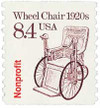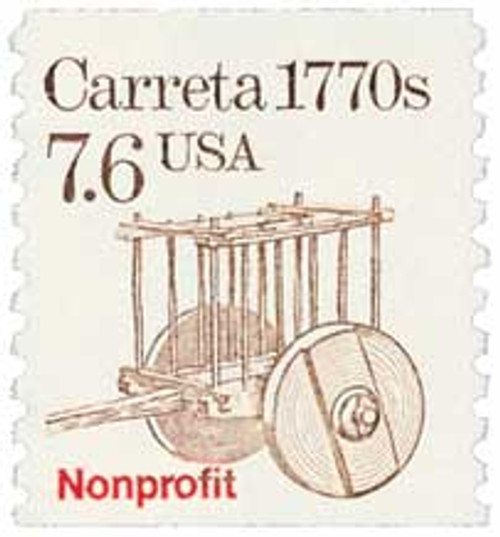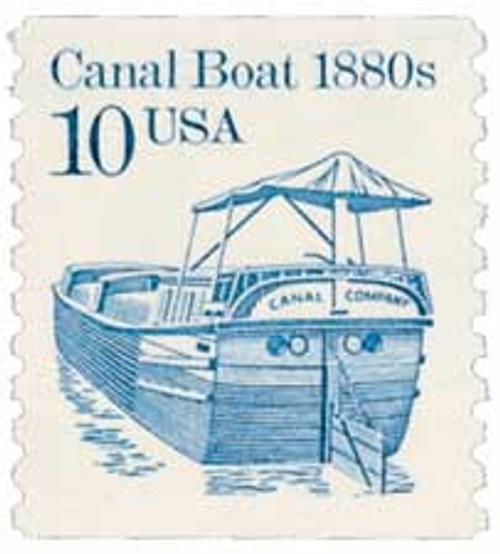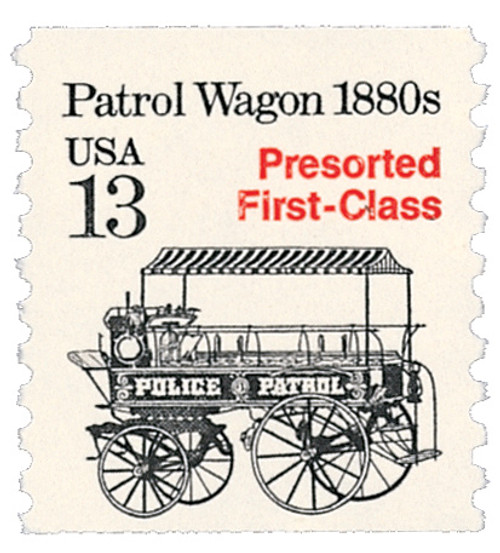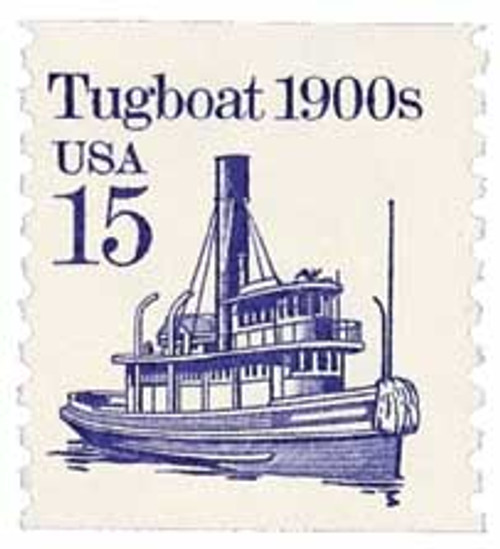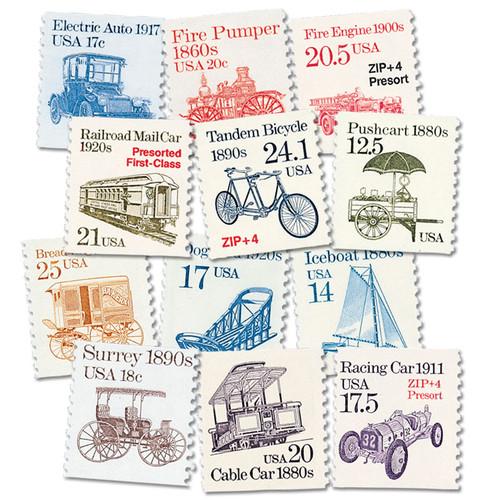
# 2256 - 1988 8.4c Transportation Series: Wheel Chair, 1920s
U.S. #2256
1988 8.4¢ Wheel Chair, 1920s
Transportation Series
- 36th stamp in Transportation Series
- Issued for a rare rate decrease
Stamp Category: Definitive
Series: Transportation
Value: 8.4¢, rate for third-class bulk mailings by non-profits
First Day of Issue: August 12, 1988
First Day City: Tucson, Arizona
Quantity Issued: 321,624,000
Printed by: Bureau of Engraving and Printing
Printing Method: Engraved
Format: Coils of 500 and 3,000
Perforations: 10 vertical
Color: Deep claret
Why the stamp was issued: To pay the decreased rate for third-class bulk mailings by non-profits, replacing the 1987 8.5¢ Tow Truck stamp. This was one of the rare instances where a rate was decreased instead of increased.
About the stamp design: This was the first Transportation stamp design by Christopher Calle, a frequent USPS stamp artist. He used a 1928 wheelchair made by the Invacare Corporation as the inspiration for his stamp art. The wicker chair as a wheel in the center of the back and two large front wheels driven by belts connected to hand cranks.
Special design details: This stamp has a “Nonprofit” precancel. Precancels are stamps canceled before being sold, to make mailing faster and cheaper for customers with large amounts of mail. Bulk mailers use precancels, then pre-sort their mail and save money.
About the printing process: Early printings of this stamp were produced on the B press, but ink drying issues slowed down production. The rest of the stamps were printed on the C press and issued two months later on October 6. The only visible difference in the two printings is that the plate number appears every 48 stamps on the C press and every 52 stamps on the B press.
First Day City: The First Day ceremony for this stamp was held at the Veterans Administration Medical Center in Tucson, Arizona.
Unusual fact about this stamp: Error varieties have been found imperforate.
About the Transportation Series: On May 18, 1981, the USPS issued the first stamp in the Transportation Series, US #1907, picturing the Surrey, a doorless four-wheeled carriage. For the first time in US history, a coil stamp featured its own unique design rather than simply copying that of the current definitive stamp. Over 50 more coil stamps would be issued over the course of the next 15 years, each picturing a different mode of transportation. All of these types of transportation were used since American independence.
The various denominations provided face values to exactly match the rates for several categories of Third-Class mail (bulk rate and quantity-discounted mail). As the rates changed, new stamps with new values were added. Never before had a stamp series included so many fractional cent values.
The Bureau of Engraving and Printing printed most of the stamps in the Transportation Series, although private contractors printed a few. All but a few of the later stamps were produced by engraved intaglio. Differences in precancels, tagging, paper and gum provide a large number of varieties.
Scott Catalog separates the Transportation stamps into four groups. The stamps in the first group (#1897-1908) generally have the denomination in small type with a “c” next to it. These stamps were printed on the Cottrell rotary press, which joined together two plates to make a sleeve. The gaps between these plates created depressions where ink would collect and create joint lines on the stamps. Later issues were printed on a different press and didn’t have these joint lines.
The second group (#2123-36) had larger numbers with no “c.” The third group (#2252-66) was similar in appearance to the second group, but service inscriptions were added to the designs. These stamps also used a variety of paper and gum as well as different types of tagging. The fourth group (#2451-68) marked the end of fractional values. Now bulk mailers would use either the 5¢ or 10¢ stamp and then pay the difference from the actual postage rate.
The last stamp in the Transportation Series, the 20¢ Cog Railway, was issued on June 9, 1995, at the TEXPEX ’95 stamp show in Dallas, Texas. This marked the end of the largest US definitive series up to that time. Three new series would eventually replace it – American Transportation, American Culture, and American Scenes. Additionally, the Great Americans would go on to become the largest American definitive series.
History the stamp represents: President Franklin D. Roosevelt probably used a wheelchair similar to the 1928 model pictured on this stamp. Developed in 1640 by a paraplegic German watchmaker, the first wheelchairs were cumbersome and expensive. In the early 20th century, it was redesigned to be more lightweight, less expensive, and easier to maneuver. Today, it allows thousands full participation in life, despite their physical disabilities.
U.S. #2256
1988 8.4¢ Wheel Chair, 1920s
Transportation Series
- 36th stamp in Transportation Series
- Issued for a rare rate decrease
Stamp Category: Definitive
Series: Transportation
Value: 8.4¢, rate for third-class bulk mailings by non-profits
First Day of Issue: August 12, 1988
First Day City: Tucson, Arizona
Quantity Issued: 321,624,000
Printed by: Bureau of Engraving and Printing
Printing Method: Engraved
Format: Coils of 500 and 3,000
Perforations: 10 vertical
Color: Deep claret
Why the stamp was issued: To pay the decreased rate for third-class bulk mailings by non-profits, replacing the 1987 8.5¢ Tow Truck stamp. This was one of the rare instances where a rate was decreased instead of increased.
About the stamp design: This was the first Transportation stamp design by Christopher Calle, a frequent USPS stamp artist. He used a 1928 wheelchair made by the Invacare Corporation as the inspiration for his stamp art. The wicker chair as a wheel in the center of the back and two large front wheels driven by belts connected to hand cranks.
Special design details: This stamp has a “Nonprofit” precancel. Precancels are stamps canceled before being sold, to make mailing faster and cheaper for customers with large amounts of mail. Bulk mailers use precancels, then pre-sort their mail and save money.
About the printing process: Early printings of this stamp were produced on the B press, but ink drying issues slowed down production. The rest of the stamps were printed on the C press and issued two months later on October 6. The only visible difference in the two printings is that the plate number appears every 48 stamps on the C press and every 52 stamps on the B press.
First Day City: The First Day ceremony for this stamp was held at the Veterans Administration Medical Center in Tucson, Arizona.
Unusual fact about this stamp: Error varieties have been found imperforate.
About the Transportation Series: On May 18, 1981, the USPS issued the first stamp in the Transportation Series, US #1907, picturing the Surrey, a doorless four-wheeled carriage. For the first time in US history, a coil stamp featured its own unique design rather than simply copying that of the current definitive stamp. Over 50 more coil stamps would be issued over the course of the next 15 years, each picturing a different mode of transportation. All of these types of transportation were used since American independence.
The various denominations provided face values to exactly match the rates for several categories of Third-Class mail (bulk rate and quantity-discounted mail). As the rates changed, new stamps with new values were added. Never before had a stamp series included so many fractional cent values.
The Bureau of Engraving and Printing printed most of the stamps in the Transportation Series, although private contractors printed a few. All but a few of the later stamps were produced by engraved intaglio. Differences in precancels, tagging, paper and gum provide a large number of varieties.
Scott Catalog separates the Transportation stamps into four groups. The stamps in the first group (#1897-1908) generally have the denomination in small type with a “c” next to it. These stamps were printed on the Cottrell rotary press, which joined together two plates to make a sleeve. The gaps between these plates created depressions where ink would collect and create joint lines on the stamps. Later issues were printed on a different press and didn’t have these joint lines.
The second group (#2123-36) had larger numbers with no “c.” The third group (#2252-66) was similar in appearance to the second group, but service inscriptions were added to the designs. These stamps also used a variety of paper and gum as well as different types of tagging. The fourth group (#2451-68) marked the end of fractional values. Now bulk mailers would use either the 5¢ or 10¢ stamp and then pay the difference from the actual postage rate.
The last stamp in the Transportation Series, the 20¢ Cog Railway, was issued on June 9, 1995, at the TEXPEX ’95 stamp show in Dallas, Texas. This marked the end of the largest US definitive series up to that time. Three new series would eventually replace it – American Transportation, American Culture, and American Scenes. Additionally, the Great Americans would go on to become the largest American definitive series.
History the stamp represents: President Franklin D. Roosevelt probably used a wheelchair similar to the 1928 model pictured on this stamp. Developed in 1640 by a paraplegic German watchmaker, the first wheelchairs were cumbersome and expensive. In the early 20th century, it was redesigned to be more lightweight, less expensive, and easier to maneuver. Today, it allows thousands full participation in life, despite their physical disabilities.





